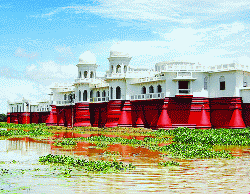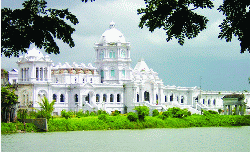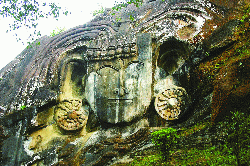Tripura is one of the seven sister states of the North eastern part of India. It is located between 22ú 56" North
 Neermahal Palace
Neermahal Palace Ujjayanta Palace
Ujjayanta PalaceMyriad in number, these places of tourist interest can be broadly categorized into:
1. Palaces – The former Maharajas of Tripura had constructed beautiful palaces in different locations of the state. These palaces provide a glimpse of the royal past of this erstwhile princely state. The main palaces are – Ujjayanta Palace, Kunjaban Palace, Malancha Niwas and Neermahal. Neermahal is situated 53 kms from Agartala. This magnificent lake palace was constructed as a summer resort in 1930 by the late Maharaja Birbikram Kishore Manikya Bahadur in the middle of a natural lake called Rudrasagar which occupies an area of 5.35 sq kms. It is the only lake palace in the whole of eastern India. The palace is segmented into two main parts, one on the western side which is called Andar Mahal which was used by the royal family; and the other on the eastern side which was used by the security personnel and servants. There is a beautiful garden on the western side of the palace in which there is an open stage where dramas and theatre were organised. The Maharajas used to reach this palace by motor boat which explains why there is a boat ghat or boat house within the palace itself. From this boat house, there are two separate stairways, one for the Maharaja and the other for his wife the Maharani. During the winter season, migratory birds flock to the lake which surrounds Neermahal which only adds to its scenic allure.
2. Rock – cut carvings and Hindu temples – Tripura is home to beautiful rock – cut carvings and stone images at Unakoti, Debtamura and Pilak. Most of these carvings are huge in size and are made on vertical walls which are exposed to the ravages of nature. They have motifs attributable to both the Hindu and Buddhist faiths. Widely diverse, there are a number of temples in this serene state, the most notable ones among which are:
a. Mata Tripuraeshwari Temple – This temple is situated in Udaipur which is about 55 kms away from Agartala. The main temple is located almost 3 kms away from the main city of Udaipur which is the district headquarters of the South Tripura district. The temple is one of the 51 pithasthans in India as per Hindu mythology. Inside the temple, the idol of Maa Kali is kept which is made of ‘reddish black Kastic stone. Maa Kali is worshipped in her ‘Soroshi’ form in this temple. There is a smaller idol of Maa Kali called ‘Chotto Maa’ and this image used to be carried by the Maharajas of Tripura during ‘Mrigaya’ or hunting expeditions and also during war.
 Unakoti
Unakotib. Fourteen Goddess Temple – It is located about 14 kms away from Agartala at a place called Old Agartala. In the face of the continued fight with Shamser Gazi, Maharaja Krishna Manikya had shifted the capital from Udaipur to Old Agartala. It continued to be the capital till it was shifted to the present day Agartala. Near the sacred Fourteen Goddess temple, during the month of July every year, a ‘Kharchi’ festival is organised which thousands of pilgrims and devotees take part in.
c. Deotamura – Located at a distance of 75 kms from Agartala, Deotamura is famous for its panels of rock carvings on the steep mountain wall on the banks of the river Gomati. There are huge images of Shiva, Vishnu, Kartika, Mahisasur Mardini Durga along with other gods and goddesses which are carved on the rock face. This place is also called ‘Chabimura’ whose literal meaning is a Hill of Pictures. These images have been found to date back to the 15th to 16th century A.D.
d. Bhuvaneswari Temple – On the right bank of the river Gomati at Udaipur, the ruins of a big palace built by Maharaja Govinda Manikya (1660 – 1675 A.D) can be found. The Bhuvaneswari temple is situated adjacent to this palace. It finds close literary reference in Rabindranath Tagore’s novels and drama, namely “Bisharjan” and ‘Rajarshi’.
e. Unakoti – Unakoti is situated 178 kms from Agartala near Kailashahar in Tripura’s North district. It is a site of Shivite pilgrimage and dates back to the 7th to 9th century A.D, if not earlier. The marvelous rock carvings and murals with their primitive beauty and waterfalls are mesmerizing. Unakoti means one less than a crore and it is said that there are that many rock carvings found here.
The images found at Unakoti are of mainly two types, namely rock – carved figures and stone images. Among the rock cut carvings, the central Shiva head and gigantic Ganesha figures deserve special mention. The central Shiva head known as ‘Unakotiswara Kal Bhairava’ is about 30 feet high including an embroidered head – dress which is 10 feet high itself. On each side of the head – dress of the central Shiva, there are two full size female figures – one of which is of Durga standing on a lion. In addition to these, there are three enormous images of Nandi Bull which are found half buried in the ground.
3. Wildlife Sanctuaries – About two thirds of the area of the state is under forest cover where different species of trees, orchids, birds and wildlife are found. The major wildlife sanctuaries are:
a. Sepahijala Wildlife Sanctuary – It is situated at a distance of 25 kms from Agartala. Sepahijala covers an area of 18.532 kms. More than 150 species of residential and migratory birds, an orchid garden, boating facilities, wildlife, a botanical garden, a zoo, elephant joy-rides, rubber and coffee plantations attract the visitors. It is also home to the famous spectacled monkey.
b. Trishna Wildlife Sanctuary – It is located at about 100 kms away from Agartala in the Belonia sub – division of Tripura’s south district. ‘Bison’ are the main attractions of this sanctuary in addition to its resident and migratory birds.
4. Fresh water lakes and water bodies – Tripura is blessed with a large number of natural and artificial lakes. Udaipur being the place where there are a number of huge lakes which were commissioned by the then Maharajas, it is known as the city of temples and lakes. Some of the major lakes and water bodyattractions of Tripura are:
a. Kamalsagar Lake – Located at a distance of 30 kms from Agartala, this vast lake at the border of Bangladesh was commissioned by Maharaja Dhanya Manikya in the 15th century. On the banks of Kamalasagar, there is a famous temple of Goddess Kali dating back to the 16th century. It is one of the most excellent picnic spots in the state as it also boasts of scenic beauty.
b. Dumboor Lake – Located at a distance of 125 kms from Agartala covering an area of almost 41 sq kms. With an unending spell of luxuriant green vegetation all around, this lake stands out for its exceedingly charming beauty and 48 islands in its midst. Migratory birds and water sports facilities are additional attractions. There is a hydel project near the lake from where river Gomati originates and this is called Tirthamukh. The lake is at the confluence of river Raima and river Sarma. It has a rich reservoir of natural and cultured fishery.
c. Rudrasagar Lake – About 55 kms away from Agartala near Melaghar and covering an area of 5.3 sq kms, Rudrasagar Lake is another big attraction in Tripura. The famous lake palace of Tripura namely Neermahal stands at the centre of the lake.
5. Jampui Hills – The Jampui Hills are situated about 200 kms from Agartala and this is the highest hill range in the state. The permanent seat of eternal spring is situated at an altitude of 3000 feet above sea level. Jampui is famous for its charming landscape and bracing climate. The excellent climatic conditions, green forests, beautiful orange gardens, the view of the rising and setting sun are wonderful sights for tourists at this place.
The hill range is home to 11 villages which are inhabitated by Mizo (Lushai tribes) and also by Reang tribes. The temperature variation in the hill range is very nominal and the sunrise and sunset here is a delight worth seeing. The natural beauty, the pleasant weather, various species of trees, orchids and orange gardens, the hospitable people and the rich cultural heritage makes this a ideal destination for tourists.
Apart from the tourist attractions, the state has a vintage flavour of its own and appears to be suspended in time. Being green all around, the small rivers and rivulets, the thatched houses in the rural areas and the close association of the local tribes with nature are things which can only imbibed in through a visit to the state.
Tripura is one of the seven sister states of the North eastern part of India. It is located between 22ú 56" North
 Neermahal Palace
Neermahal Palace Ujjayanta Palace
Ujjayanta PalaceMyriad in number, these places of tourist interest can be broadly categorized into:
1. Palaces – The former Maharajas of Tripura had constructed beautiful palaces in different locations of the state. These palaces provide a glimpse of the royal past of this erstwhile princely state. The main palaces are – Ujjayanta Palace, Kunjaban Palace, Malancha Niwas and Neermahal. Neermahal is situated 53 kms from Agartala. This magnificent lake palace was constructed as a summer resort in 1930 by the late Maharaja Birbikram Kishore Manikya Bahadur in the middle of a natural lake called Rudrasagar which occupies an area of 5.35 sq kms. It is the only lake palace in the whole of eastern India. The palace is segmented into two main parts, one on the western side which is called Andar Mahal which was used by the royal family; and the other on the eastern side which was used by the security personnel and servants. There is a beautiful garden on the western side of the palace in which there is an open stage where dramas and theatre were organised. The Maharajas used to reach this palace by motor boat which explains why there is a boat ghat or boat house within the palace itself. From this boat house, there are two separate stairways, one for the Maharaja and the other for his wife the Maharani. During the winter season, migratory birds flock to the lake which surrounds Neermahal which only adds to its scenic allure.
2. Rock – cut carvings and Hindu temples – Tripura is home to beautiful rock – cut carvings and stone images at Unakoti, Debtamura and Pilak. Most of these carvings are huge in size and are made on vertical walls which are exposed to the ravages of nature. They have motifs attributable to both the Hindu and Buddhist faiths. Widely diverse, there are a number of temples in this serene state, the most notable ones among which are:
a. Mata Tripuraeshwari Temple – This temple is situated in Udaipur which is about 55 kms away from Agartala. The main temple is located almost 3 kms away from the main city of Udaipur which is the district headquarters of the South Tripura district. The temple is one of the 51 pithasthans in India as per Hindu mythology. Inside the temple, the idol of Maa Kali is kept which is made of ‘reddish black Kastic stone. Maa Kali is worshipped in her ‘Soroshi’ form in this temple. There is a smaller idol of Maa Kali called ‘Chotto Maa’ and this image used to be carried by the Maharajas of Tripura during ‘Mrigaya’ or hunting expeditions and also during war.
 Unakoti
Unakotib. Fourteen Goddess Temple – It is located about 14 kms away from Agartala at a place called Old Agartala. In the face of the continued fight with Shamser Gazi, Maharaja Krishna Manikya had shifted the capital from Udaipur to Old Agartala. It continued to be the capital till it was shifted to the present day Agartala. Near the sacred Fourteen Goddess temple, during the month of July every year, a ‘Kharchi’ festival is organised which thousands of pilgrims and devotees take part in.
c. Deotamura – Located at a distance of 75 kms from Agartala, Deotamura is famous for its panels of rock carvings on the steep mountain wall on the banks of the river Gomati. There are huge images of Shiva, Vishnu, Kartika, Mahisasur Mardini Durga along with other gods and goddesses which are carved on the rock face. This place is also called ‘Chabimura’ whose literal meaning is a Hill of Pictures. These images have been found to date back to the 15th to 16th century A.D.
d. Bhuvaneswari Temple – On the right bank of the river Gomati at Udaipur, the ruins of a big palace built by Maharaja Govinda Manikya (1660 – 1675 A.D) can be found. The Bhuvaneswari temple is situated adjacent to this palace. It finds close literary reference in Rabindranath Tagore’s novels and drama, namely “Bisharjan” and ‘Rajarshi’.
e. Unakoti – Unakoti is situated 178 kms from Agartala near Kailashahar in Tripura’s North district. It is a site of Shivite pilgrimage and dates back to the 7th to 9th century A.D, if not earlier. The marvelous rock carvings and murals with their primitive beauty and waterfalls are mesmerizing. Unakoti means one less than a crore and it is said that there are that many rock carvings found here.
The images found at Unakoti are of mainly two types, namely rock – carved figures and stone images. Among the rock cut carvings, the central Shiva head and gigantic Ganesha figures deserve special mention. The central Shiva head known as ‘Unakotiswara Kal Bhairava’ is about 30 feet high including an embroidered head – dress which is 10 feet high itself. On each side of the head – dress of the central Shiva, there are two full size female figures – one of which is of Durga standing on a lion. In addition to these, there are three enormous images of Nandi Bull which are found half buried in the ground.
3. Wildlife Sanctuaries – About two thirds of the area of the state is under forest cover where different species of trees, orchids, birds and wildlife are found. The major wildlife sanctuaries are:
a. Sepahijala Wildlife Sanctuary – It is situated at a distance of 25 kms from Agartala. Sepahijala covers an area of 18.532 kms. More than 150 species of residential and migratory birds, an orchid garden, boating facilities, wildlife, a botanical garden, a zoo, elephant joy-rides, rubber and coffee plantations attract the visitors. It is also home to the famous spectacled monkey.
b. Trishna Wildlife Sanctuary – It is located at about 100 kms away from Agartala in the Belonia sub – division of Tripura’s south district. ‘Bison’ are the main attractions of this sanctuary in addition to its resident and migratory birds.
4. Fresh water lakes and water bodies – Tripura is blessed with a large number of natural and artificial lakes. Udaipur being the place where there are a number of huge lakes which were commissioned by the then Maharajas, it is known as the city of temples and lakes. Some of the major lakes and water bodyattractions of Tripura are:
a. Kamalsagar Lake – Located at a distance of 30 kms from Agartala, this vast lake at the border of Bangladesh was commissioned by Maharaja Dhanya Manikya in the 15th century. On the banks of Kamalasagar, there is a famous temple of Goddess Kali dating back to the 16th century. It is one of the most excellent picnic spots in the state as it also boasts of scenic beauty.
b. Dumboor Lake – Located at a distance of 125 kms from Agartala covering an area of almost 41 sq kms. With an unending spell of luxuriant green vegetation all around, this lake stands out for its exceedingly charming beauty and 48 islands in its midst. Migratory birds and water sports facilities are additional attractions. There is a hydel project near the lake from where river Gomati originates and this is called Tirthamukh. The lake is at the confluence of river Raima and river Sarma. It has a rich reservoir of natural and cultured fishery.
c. Rudrasagar Lake – About 55 kms away from Agartala near Melaghar and covering an area of 5.3 sq kms, Rudrasagar Lake is another big attraction in Tripura. The famous lake palace of Tripura namely Neermahal stands at the centre of the lake.
5. Jampui Hills – The Jampui Hills are situated about 200 kms from Agartala and this is the highest hill range in the state. The permanent seat of eternal spring is situated at an altitude of 3000 feet above sea level. Jampui is famous for its charming landscape and bracing climate. The excellent climatic conditions, green forests, beautiful orange gardens, the view of the rising and setting sun are wonderful sights for tourists at this place.
The hill range is home to 11 villages which are inhabitated by Mizo (Lushai tribes) and also by Reang tribes. The temperature variation in the hill range is very nominal and the sunrise and sunset here is a delight worth seeing. The natural beauty, the pleasant weather, various species of trees, orchids and orange gardens, the hospitable people and the rich cultural heritage makes this a ideal destination for tourists.
Apart from the tourist attractions, the state has a vintage flavour of its own and appears to be suspended in time. Being green all around, the small rivers and rivulets, the thatched houses in the rural areas and the close association of the local tribes with nature are things which can only imbibed in through a visit to the state.







































.jpg)




























































